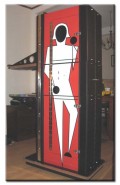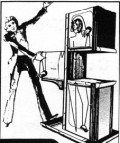Zig Zag Girl
Designer: Robert Harbin
The Zig Zag Girl was created by Robert Harbin and detailed in the “Magic of Robert Harbin. Owners of this book are authorized to build and perform the illusion. [1]
The Zig Zag Girl was invented by Robert Harbin in the mid 1960’s. It has been hailed as one of the greatest illusions ever invented due to both the apparent impossibility of the trick and the fact that it can be performed surrounded.
The Zig Zag Girl illusion is a vertical version of the “sawing a woman in half” illusion. The assistant is placed in an upright cabinet with her face, hands, and left foot visible through openings in the cabinet’s front. Large, metallic blades are inserted horizontally in the cabinet’s mid-section, dividing it—and the assistant inside—into thirds. The magician then slides the cabinet’s mid-section apart from the cabinet’s top and bottom thirds, giving the appearance that the assistant’s mid-section has been pulled away from the rest of her, giving her a “zig-zag” shape. While divided, a small door on the cabinet’s mid-section can be opened to examine—even touch—the assistant’s body inside, a duty frequently performed by an audience member brought up on stage to help perform the illusion. At the completion of the illusion, the assistant’s mid-section is slid back into place, the two blades removed, and she steps out of the cabinet unscathed. Because of the manner in which the illusion is achieved, it is generally performed with a female assistant, and there are limitations on her height and weight. Some of these issues are overcome in Modern Art, the illusion created by Jim Steinmeyer.
Robert Harbin released only 500 copies of his plans in The Magic of Robert Harbin in 1970. The printing plates were then destroyed, and Harbin claimed the effect was never to be released again. The Magic Circle now holds the rights to this book. An “authorized” version of this illusion will be accompanied by this book (which may cost a couple thousand dollars as they are now collector’s items). However, the method has become widely known and many thousands of Zig Zags exist today. In fact, the Guinness Book of World Records, 2005, p. 182 claimed the following:
- Most Copied Stage Illusion
Invented by Robert Harbin (South Africa) in 1965, the Zig Zag girl is the most popularly performed stage illusion in the world. A girl, standing in an upright cabinet, is apparently cut into three pieces and has the middle of her body pulled to one side. It was copied so quickly that Harbin published a highly-priced book in 1970 (limited to 500 copies) which allowed each purchaser to build one version of the prop. It is estimated that at least 15,000 Zig Zag illusions have been built to date, meaning that 14,500 are unauthorized copies.
Dick Williams was the first to perform the authorized version on American TV (April 4th, 1971). The Zig Zag Girl clearly remains one of the most commonly performed illusions on the stage. In recent years, some magicians have made small modifications including the assistant’s head being visible instead of just her face. In another version, the assistant is divided into five pieces instead of three.
The Magic Circle has not released this illusion to the public and refused permission to show the original Harbin photos from the Magic of Robert Harbin. The photos shown here were from the public broadcast of Harbin on TV.
Photo Credit: Rich Hill (painted)
SOURCES
[1] Robert Harbin, The Magic of Robert Harbin. (London, C. W. Mole & Sons, Ltd., 1970).




